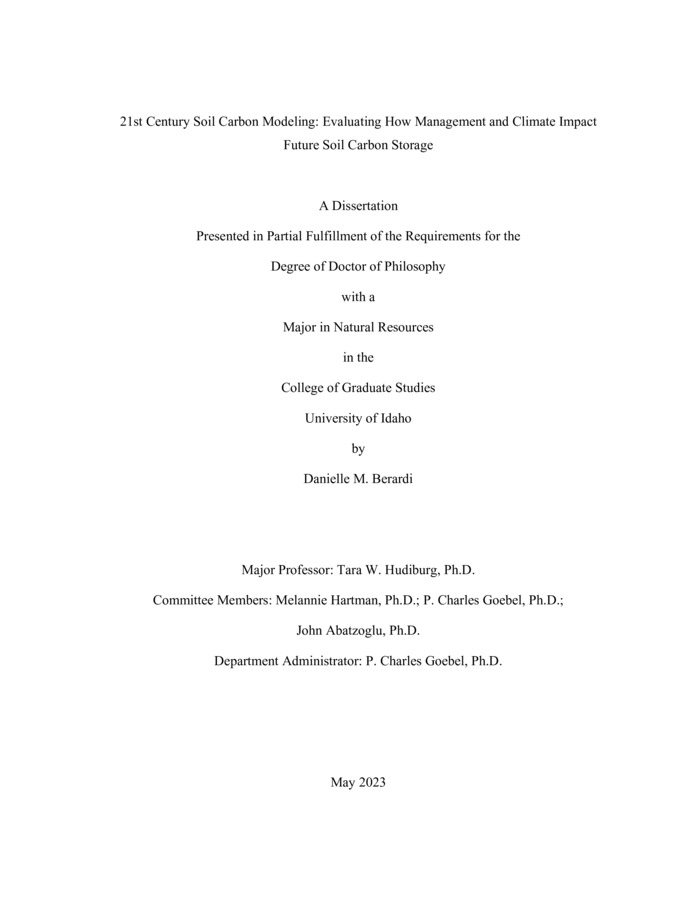21st Century Soil Carbon Modeling: Evaluating How Management and Climate Impact Future Soil Carbon Storage
Berardi, Danielle M. (2023-05). 21st Century Soil Carbon Modeling: Evaluating How Management and Climate Impact Future Soil Carbon Storage. Theses and Dissertations Collection, University of Idaho Library Digital Collections. https://www.lib.uidaho.edu/digital/etd/items/berardi_idaho_0089e_12646.html
- Title:
- 21st Century Soil Carbon Modeling: Evaluating How Management and Climate Impact Future Soil Carbon Storage
- Author:
- Berardi, Danielle M
- ORCID:
- 0000-0003-1414-3080
- Date:
- 2023-05
- Keywords:
- Bioenergy Biogeochemistry Ecosystem modeling Soil Carbon
- Program:
- Forest, Rangeland & Fire Sci
- Subject Category:
- Ecology
- Abstract:
-
Cellulosic bioenergy crops have potential to meet United States greenhouse gas (GHG) reduction targets and provide energy self-sufficiency. The Renewable Fuel Standard (RFS) calls for increasing the volume of cellulosic biofuel by 16 billion gallons while reducing lifecycle GHG emissions by 60%. Consideration of crop selection, location, and management strategies is critical to meet these goals and prevent environmental and economic costs from outweighing benefits. Depending on the productivity of selected land, 33 to >50 million hectares are required for cellulosic bioenergy production to meet RFS targets. Because a variety of factors are critical to a successful transition to cellulosic bioenergy, biogeochemical modeling is an essential tool to assessing potential scenarios. Models can evaluate potential yield, carbon pools and fluxes, and other GHG and nitrogen fluxes (e.g. nitrous oxide and methane emissions, nitrate leaching) with varying landscapes and management. The first chapter of this dissertation is a review on the current state of biogeochemical modeling and what improvements are necessary to evaluate the sustainability of varying crops, locations, and management to better inform economic models and policy decisions to meet RFS targets. Representation of soil carbon dynamics in most models is oversimplified with decay constant (i.e. first-order kinetics) driven decomposition and soil carbon pool structures that do not align with measurable pools or current understanding of soil carbon stabilization. Increasing microbial representation in models has shown to reduce uncertainty of predicted soil carbon. This is important not only from a GHG perspective, but also because soil carbon dynamics are intertwined with soil health attributes that increase landscape resiliency (i.e. soil fertility, water holding capacity, and erosion resistance). The second chapter integrates and evaluates microbial explicit mechanisms of decomposition into a new soil sub-model within a version of DayCent that was recently updated to encompass plant traits specific to perennial bioenergy crops. Specifically, the new soil sub-model uses reverse Michaelis-Menten kinetics that incorporate feedbacks between microbial biomass and decomposition rate to simulate soil carbon fluxes. Along with a modified decomposition function the Michaelis-Menten (MM) version of the soil model split the original active soil carbon pool into a live microbial biomass pool and a dead microbial biomass pool with more realistic routing of soil carbon through the pool structure. With these changes, the new MM soil sub-model improved daily representation of ecosystem carbon fluxes and simulated different ratios of protected to unprotected soil carbon in response to disturbance and climate compared to the original first order soil sub-model. With improvements to the soil model, DayCent will be better suited to evaluate yield, soil health, and GHG balances across landscapes. Identifying appropriate locations for a particular crop is paramount to meeting GHG atmospheric loading reductions, fulfilling socioeconomic needs, and achieving sustainable land use. In comparison to traditional agricultural crops, some bioenergy crops have physiological attributes (e.g. low N requirements, high belowground biomass, no tillage) that will outweigh the potential negatives if planted strategically. However, there is still much uncertainty and controversy surrounding where cellulosic bioenergy crops will be grown. Conversion of land to cellulosic bioenergy crops that is currently used for food production raises concerns about food-scarcity and sequential conversion of uncultivated land converted for food production (indirect land-use change) resulting in catastrophic losses of sequestered carbon and ecosystem services that will not be recouped through annual row crop production. Conversion of land to bioenergy crops that is not currently used for agricultural production also raises environmental concerns including the effects on GHG balances, biodiversity and ecosystem services, increasing reactive nitrogen through fertilizer, and water use. These potential side effects of conversion are thought to be largely avoided if bioenergy crops are produced on land that has been deemed marginal, or unproductive land that was used for agriculture in the recent past. Chapter three identifies current cropland that is likely to experience increased yield losses as a result of increasing climate variability (aka "marginal land") and analyzes the potential for growing more tolerant bioenergy crops using updated features of the DayCent model. Targeting low-lying, flood susceptible fields for conversion to switchgrass would provide a path to adapt agricultural practices to changing precipitation regimes, mitigate increasing climate variability, and reduce negative environmental impacts of corn production. Documented benefits of perennial grasses in riparian zones include reduced phosphorus and nitrate exports to waterways, decreased nitrous oxide emissions and increased soil carbon sequestration. In comparison to corn-soy production, I found that perennial bioenergy crops in selected flood prone areas will have 1) similar to higher yield, 2) higher soil carbon sequestration, and 3) lower GHG emissions and nitrate exports in flood prone areas because of lower risk to losses attributed to flooding, higher belowground biomass, decreased erosion, and greater productivity. Lower rates of nitrate leaching and nitrous oxide emissions are expected because switchgrass does not require fertilization.
- Description:
- doctoral, Ph.D., Forest, Rangeland & Fire Sci -- University of Idaho - College of Graduate Studies, 2023-05
- Major Professor:
- Hudiburg, Tara W
- Committee:
- Hartman, Melannie; Goebel, P. Charles; Abatzoglu, John
- Defense Date:
- 2023-05
- Identifier:
- Berardi_idaho_0089E_12646
- Type:
- Text
- Format Original:
- Format:
- application/pdf
- Rights:
- In Copyright - Educational Use Permitted. For more information, please contact University of Idaho Library Special Collections and Archives Department at libspec@uidaho.edu.
- Standardized Rights:
- http://rightsstatements.org/vocab/InC-EDU/1.0/

